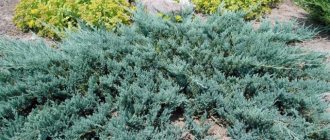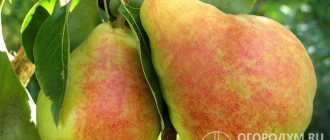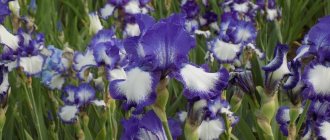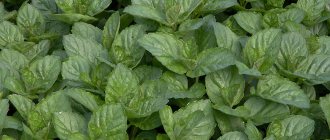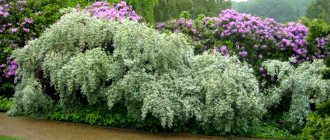Iris plant: description
This is a perennial and unique herbaceous plant with a strong rhizome. There are two types of shoots: vegetative and generative. Thin leaves with a waxy coating are united by fan-shaped bunches at the base of the peduncles.
Some varieties have no stem leaves or very few of them. Single flowers are located in inflorescences; they have a unique aroma and elegant shape. There is a huge palette of shades from snow-white to dark purple. Large and beautiful flowers are made up of six petal-shaped lobes. The three outer lobes tend to slope slightly downward.
Popular message topics
- Interesting facts about Pushkin
One of the greatest poets of all times and people is A. S. Pushkin. He is recognized as the founder of the Russian literary language. He became one of the important national playwrights. Those people who met with the work of this writer, - Cats Cats
are graceful and very beautiful. Animals have sharp claws, which help them climb trees with ease, and also jump deftly. The body of cats is mainly covered with hair, but there are also species of cats without hair. They have a long tail and ears. - Polymers Polymers
are high molecular weight (more than 10,000 daltons) compounds consisting of repeating low molecular weight structural units (monomers). The number of these units is called the degree of polymerization.
Iris plant: characteristics and description of varieties
Iris boasts a variety of colors and long flowering times. Popular varieties:
- Bearded is the most popular among garden irises. On the outer petals at the base there are stripes of hairs, which are very noticeable against the general background. There are low-growing, medium-growing and large-growing plants. Height reaches 70 cm.
- The Siberian iris plant is distributed from the north of Italy to Lake Baikal. This species is also found in the Caucasus, Turkey and the Komi Republic. There are several huge leaves on the branched stem. Magnificent flowers are located on stalks. Light gray seeds were hidden in the box.
- Dwarf is common in arid grass steppes. In addition, it can be found on limestone slopes and sands. The iris reaches a height of no more than 15 cm. The leaves are bluish in color. The peduncle is approximately 3 cm high; the plant begins to bloom in May. Tolerates lack of moisture very well.
- Dutch has a special underground organ instead of a rhizome, which contains reserves of nutrients. The stem has dense, narrowly grooved leaves. The peduncle grows on average 80 cm. The flower can be one-color or two-tone. This variety is very heat-loving and in winter needs protection from wind and cold.
- The marsh iris plant has attractive bright yellow flowers, decorated with gnarled streaks. Blooms from early May to June. This variety is heat-loving and winter-hardy, loves direct sunlight. In the wild it grows mainly near river floodplains and the banks of reservoirs. It can be seen in Europe, China and the Far East.
- Ensiform is considered a late-flowering variety. The leaves are not wide and do not exceed 40 cm in height. The flowers are flat with small inner and wide outer petals. The height of the peduncle is approximately 70 cm. It begins to bloom in mid-summer and blooms until the end of August.
Brief characteristics of the iris plant:
Bearded irises get their name from their colored hairs located on the outer perianth lobes. The hairs resemble a beard in appearance.
Siberian varieties are distinguished by their unpretentiousness and resistance to frost. In addition, cut leaves have decorative value.
Japanese irises can be divided only after five to seven years, since they retain their decorative properties and productivity for a longer time. In early spring or autumn, division of this species is carried out.
There are three groups of irises:
- low-growing - the height of the peduncle is 20–35 cm;
- medium-sized - peduncle from 35 to 70 cm;
- tall - peduncle more than 70 cm.
Links
Wikisource has texts on the topic Iris
- Kasatik // Great Soviet Encyclopedia: [in 30 volumes] / ch. ed. A. M. Prokhorov. — 3rd ed. - M.: Soviet Encyclopedia, 1969-1978. (Retrieved November 14, 2009)
- Kasatik // Encyclopedic Dictionary of Brockhaus and Efron: in 86 volumes (82 volumes and 4 additional). - St. Petersburg, 1890-1907. (Retrieved November 14, 2009)
- [flower.onego.ru/other/iris.html Iris] on the website [flower.onego.ru Encyclopedia of ornamental garden plants].
- [irisgarden.net/books/siber.htm Siberian iris yesterday, today and tomorrow. Bulletin of the AIS.] on the website [irisgarden.net/ Iris Garden.] (Translation from English.)
- [irisgarden.net/books/siberian.htm Pirogov Yu. Siberian irises.] on the website [irisgarden.net/ Iris Garden.]
- [irisgarden.net/books/spuria.htm Pirogov Yu. Spuria irises.] on the website [irisgarden.net/ Iris Garden.]
- [www.arilsociety.org Aril Irises International] - Website of the most significant association of iris lovers of the Onko and Regelia sections.
- [samlib.ru/k/koncheew/iris.shtml Hermann Hesse “Iris”]
- [www.britishirissociety.org.uk/index.html British Iris Society]
- Golikov K.
[www.greeninfo.ru/grassy/iris_hybrida.html/Article/_/aID/4985 Garden classification of irises]. CC Green Line. Retrieved September 16, 2013. - Golikov K.
[www.greeninfo.ru/grassy/iris_hybrida.html/Article/_/aID/4984 What else you need to know about the classification of irises]. Retrieved September 16, 2013. - Golikov K.
[www.greeninfo.ru/grassy/iris_hybrida.html/Article/_/aID/4983 Agricultural technology of irises]. Retrieved September 16, 2013.
Peculiarities
Depending on the type, the iris plant (planting and care of which is described below) also has different root systems. They are thin, fibrous, fleshy and few-branched. The leaves are usually xiphoid, with a waxy coating, and green in color. The condition of the flower can be determined by its bloom. An even layer means that the iris does not get sick. The leaves retain their decorative appearance until the beginning of autumn. The flowers are large, of various colors (blue, white, blue, pink, etc.). Several shades of flowers can be on one corolla, but a single color is not uncommon.
Notes
- For the convention of indicating the class of monocots as a higher taxon for the group of plants described in this article, see the section “APG Systems” of the article “Monocots”.
- Rodionenko G.I.
Genus Iris - Iris L. - M.-L., 1961. - 216 p. - [wiki.irises.org/bin/view/Main/InfoClassificationTreatmentByMathew A classification of Iris
by Mathew] - [www.theplantlist.org/1.1/browse/A/Iridaceae/Iris/ Iris
] (English). The Plant List. Version 1.1. (2013). Retrieved 2016-08-60. - ↑ 1 2 3 4 Gubanov I. A. et al.
[ashipunov.info/shipunov/school/books/dikor_polezn_rast_sssr1976.djvu Wild useful plants of the USSR] / Responsible. ed. T. A. Rabotnov. - M.: Mysl, 1976. - P. 73. - (Reference books for geographers and travelers). - Blinova K. F. et al.
[herba.msu.ru/shipunov/school/books/botaniko-farmakognost_slovar1990.djvu Botanical-pharmacognostic dictionary: Reference. allowance] / Ed. K. F. Blinova, G. P. Yakovleva. - M.: Higher. school, 1990. - P. 192. - ISBN 5-06-000085-0. - Melnichenko T. A.
Merchandising of perfumery and cosmetic products" (for secondary specialized educational institutions). - Rostov: Phoenix, 2002. - P. 18. - [www.kavb.nl/index.cfm?act=esite.tonen&pagina=106 De database Geregistreerde cultivars]
- [www.irisregister.com/ Online database of AIS Check Lists and registered iris names]
- [irises.org/About_Irises/Classifications.html Iris Classifications] at [irises.org The American Iris Society]
- Pirogov Yu.
Irises. - M.: ZAO "Fiton+", 2009 - P. 8 - ISBN 978-5-93457-281-6 - Iris Check List of Registered Cultivar Names. 1990—1999./Ed. Keith Keppel. - Hannibal, NY: The American Iris Society, Inc, 2001—549 p. — ISBN 1-892400-04-9
- [apps.rhs.org.uk/rhsplantfinder/plantnaming/classgenera.asp Classification of genera] on the website [apps.rhs.org.uk The Royal Horticultural Society]
- Komarnicki L.
[www.britishirissociety.org.uk/hybrids_lech%20komarnicki%20feb.2012.pdf Interspecies and Interseries Crosses of Beardless Irises] - [web.archive.org/web/20101219060513/ruiris.narod.ru/page8.html Garden classification of irises] on the website [ruiris.narod.ru/index.html ROI]
- Lavrova S.
A. Kingdom of Flora: Flowers and trees in legends and myths. - M.: White City, 2009. - P. 132. - ISBN 978-5-7793-1681-1. - [www.agape-biblia.org/books/Book05/P071.HTM V. Dal ESCAPE - SEARCH.]
Growing
Japanese irises love warm weather, so if they are bred in northern regions, they grow well and bloom mainly indoors. Siberian varieties are frost-resistant, and bearded irises are less demanding than the two above-mentioned species.
Cultivation of plants requires drained, fertile and moist soil. Excess moisture is removed. When planting a plant in heavy soils, it is recommended to add garden soil, sand or special fertilizers. Top dressing is applied at the rate of half a ten-liter bucket per 1 m2. If soil neutralization is needed, bone meal is used; Siberian irises do not like lime.
Literature
- Rodionenko G.I.
Genus Iris - Iris L. - M.-L., 1961. - 216 p. - [flowerlib.ru/books/item/f00/s00/z0000035/index.shtml Irises] / Ed. Doctor of Biological Sciences Rodionenko G.I. - M.: Kolos, 1981. - 156 p.
- Bondarenko L.
[www.litbulbgarden.com/article/article5.php Iridodictiums] // Floriculture: Journal. - 2004. - No. 2. - G. I. Rodionenko.
On the independence of the genus Xyridion (Iridaceae) // Botanich. magazine - SPb: St. Petersburg. ed. RAS, 2005. - T. 90, issue. 1. - pp. 55-59. — ISSN [www.sigla.ru/table.jsp?f=8&t=3&v0=0006-8136&f=1003&t=1&v1=&f=4&t=2&v2=&f=21&t=3&v3=&f=1016&t=3&v4=&f=1016&t=3&v5 =&bf=4&b=&d=0&ys=&ye=&lng=&ft=&mt=&dt=&vol=&pt=&iss=&ps=&pe=&tr=&tro=&cc=UNION&i=1&v=tagged&s=0&ss=0&st=0&i18n=ru&rlf=&psz =20&bs=20&ce=hJfuypee8JzzufeGmImYYIpZKRJeeOeeWGJIZRrRRrdmtdeee88NJJJJpeeefTJ3peKJJ3UWWPtzzzzzzzzzzzzzzzzbzzvzzpy5zzjzzzzzzzzzzzzzzzzzzzzzzzzz zzzzztzzzzzzzbzzzzzzzzzzzzzzzzzzzzzzzzzzzzzzzzzyeyTjkDnyHzTuueKZePz9decyzzLzzzL*.c8.NzrGJJvufeeeeeJheeyzjeeeeJh*peeeeKJJJJJJJJJmjHvOJJJJJJJJfe eeieeeeSJJJJSJJJ3TeIJJJJ3..E.UEAcyhxD.eeeeeeuzzzLJJJJ5.e8JJJheeeeeeeeeeeeyeyeK3JJJJJJJJ*s7defeeeeeeeeeeeeeeeeeeeeeeeeSJJJJJJJZIJJzzz1..6LJJJJJJtJJZ4….EK*&deb ug=false 0006-8136].
Adding Nutrients
During growth and development, the plant requires feeding with inorganic complex fertilizers, which include potassium, phosphorus and nitrogen. Fertilizers are applied three times. The first is as soon as the plant emerges from the soil. The second time - approximately thirty days after the first application of fertilizing. And the last time was when the plant bloomed.
Another method can be used. In the first stage, only nitrogen and phosphorus substances are added. In the second, potassium is added to the previous elements, and in the third place, only potassium and phosphorus fertilizers are added. During the growing season, nine grams of the above fertilizers should be applied per square meter. Fertilizer is added exclusively in liquid form.
General information
Irises are common almost everywhere, as they are unpretentious and, therefore, are especially popular among flower lovers. This plant is mentioned in many ancient legends, myths, tales and signs. The flower is a symbol of hope and trust, friendship and strong ties.
Today, irises are grown not only as garden decorations, they are also used in the production of confectionery (there is even jam made from iris flowers), as well as in perfumery and medicine.
We will talk about the characteristics of the plant and the rules for caring for it below. Let's talk about flowers that look like irises.
Reproduction
Work on dividing the roots is carried out at the end of the summer or at the beginning of autumn, after about four years of the plant growing in one place. If this operation is not carried out, the iris will not bloom, since four years after planting the flower buds stop forming. For this reason, to obtain abundant flowering, the roots should be divided or their upper part removed.
One of the simple methods of dividing rhizomes is the formation of annual links with a bunch of leaves. Each link is divided into separate pieces with buds. After cutting, they are left in a dry, warm room for 48 hours, during which time the sections form protective wound tissue. In addition, the cuts can be sprinkled with crushed coal.
The seedlings are placed in containers and stored indoors, as rooting occurs in winter. Rhizomes dug up in the fall should be stored in a cool, dry place. When planting roots in spring, they are cut to 8–10 cm in advance, and by two-thirds in autumn or summer.
Replanting after 4–5 years is quite a long time, so the plant can be propagated by seeds. Each variety has its own characteristics. Siberian and Japanese irises can be grown from seeds without any problems, but bearded irises are a little more difficult, since their seeds have a thick cover, and seedlings appear in the second or third year. Scientists believe that propagation by seeds is best used in selection, since this method does not guarantee good plant growth.
Care
For Siberian and Japanese varieties, soils that are well able to retain moisture are suitable, while for bearded varieties soil with a slightly acidic or neutral environment is suitable. Non-chernozem soil must be fertilized.
Each type of plant needs a different amount of water. For example, Siberian iris requires constant watering during the flowering period, while bearded iris prefers moderate watering.
It is best to place irises in sunny or semi-shaded areas. If you plant a plant in continuous shade, it will stop flowering. Japanese and bearded species can tolerate severe shade.
Useful properties of the plant
Currently, only a few varieties of the iris plant are acceptable for use in medical practice. For example, Florentine and German. The main raw material is the roots of the plant due to the content of its unique essential oil. Three years after planting the iris, they begin to harvest them. The roots are washed with water, cleared of lateral shoots, and then dried. Store in closed containers.
The roots of irises contain a huge amount of ascorbic acid, starch, sugar and many other equally useful components.
Growth conditions
Many varieties of this plant can rebloom in the fall. It should be noted that only 2-3 years after planting the plant, all the splendor and beauty of irises is revealed.
Growing these flowers on a plot is not a very difficult matter, but there are some peculiarities. Irises prefer light soils with an alkaline reaction. They may not bloom in acidic soils, but in them the flowers quickly and well develop the leaf apparatus. To neutralize acidic soils, you can add a little lime or ash.
If necessary, fertilizers are applied approximately 10 days before planting. Depleted soils are better suited for iris than overly fertilized ones. From an excess of the latter, the plant may die. Thus, in terms of applying organic fertilizers (for example, manure), maintenance is not so difficult. The iris flower can be fed with mineral mixtures.
It should be noted that another reason for the lack of flowering may be planting the plant in the shade. These flowers are light-loving. Of course, among the rhizomatous irises there are plants that bloom in the partial shade of trees. However, not a single bulbous variety likes shade. In addition, the tightness and great depth of the plant’s roots can also cause some problems when growing.

